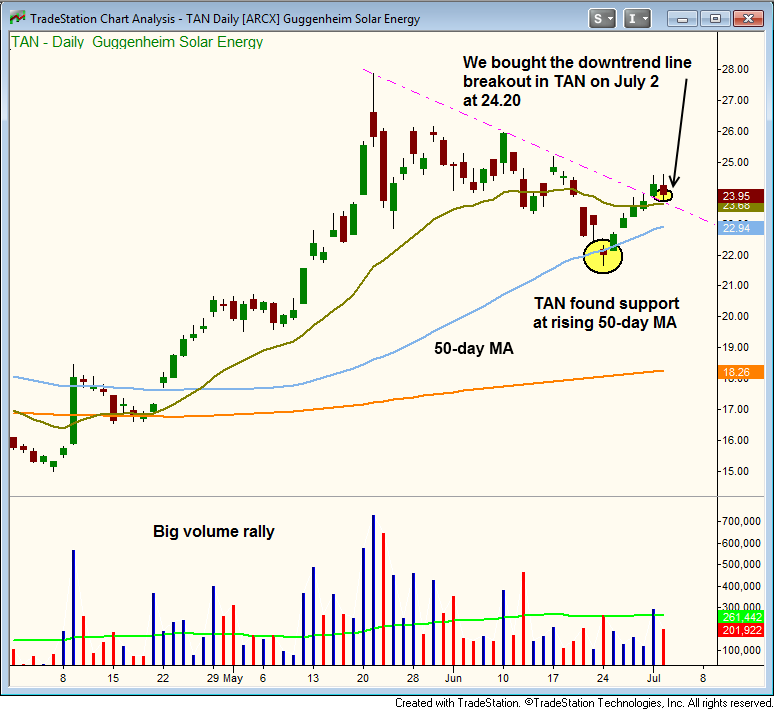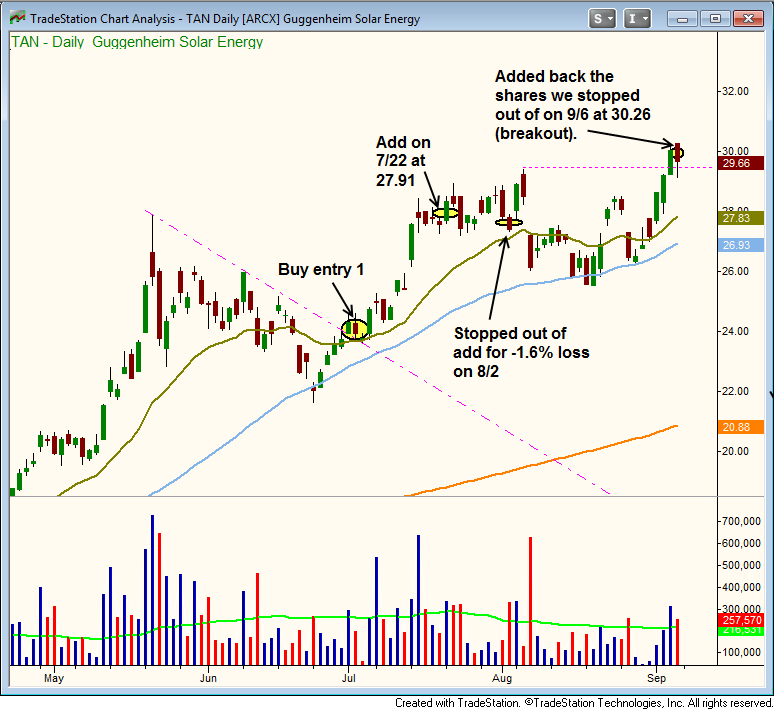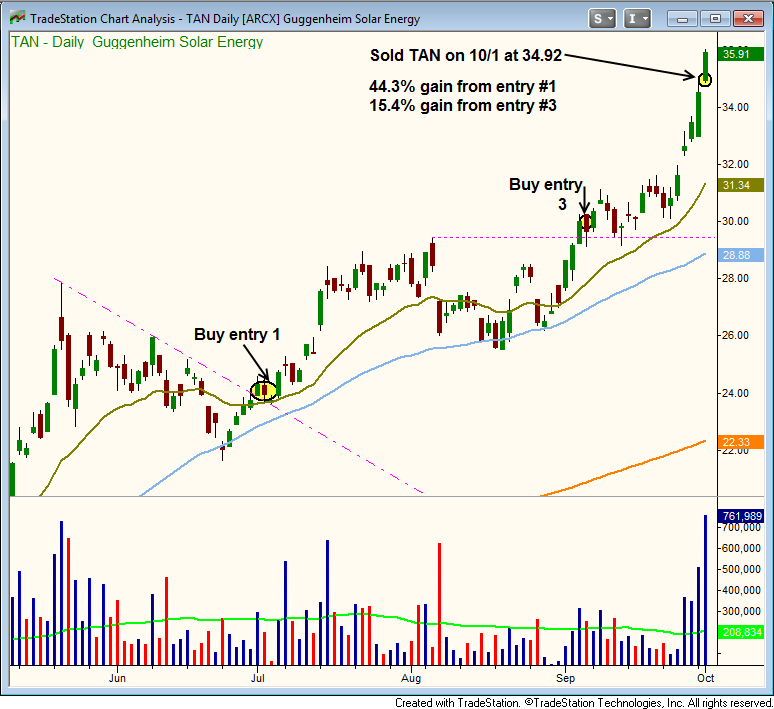In this trading strategy article, we detail the top 4 technical tips that prompted us to buy Guggenheim Solar, (TAN) when we did.
Then, we walk you through to the day when we eventually exited the trade to lock in the profits.
Here’s a snapshot of how the daily chart of TAN appeared at the time of our initial trade entry. The 4 reasons we bought this ETF immediately follow:
4 Big Tips For ETF Traders
- Sector Relative Strength - As detailed in my first ETF book, one of the first steps of my ETF trading strategy is to identify the industry sector showing the most relative strength to the benchmark S&P 500 Index. In early May, the relative strength of the solar energy sector became very apparent to us, prompting us to add TAN to our watchlist for potential trade entry.
. - Uptrend Confirmed - When a stock or ETF breaks out to the upside, we have a basic trend qualifier that we utilize in order to confirm a valid uptrend is in place before tending to buy the stock. Specifically, the 20-day exponential moving average must be above the 50-day moving average, and 50-day MA must be above the 200-day MA. Additionally, all three moving averages must be trending upwards. Although TAN initially pushed above its 50-day MA back on April 8 (the big green bar accompanied by the volume spike), it wasn’t until mid-May that TAN met our trend qualifier requirement.
. - Big Volume Breakout - The best breakouts are always accompanied by increasing volume in which turnover spikes to 2 to 3 times its average daily level. After mid-May, when bullish momentum really started pushing tan higher, notice how volume picked up as well. Such volume spikes are like stepping on the gas pedal for a breakout, and help to confirm the legitimacy of a breakout as well. Unlike other technical indicators that frequently give false readings, volume is the one indicator that never lies.
. - First pullback to 50-day MA - Because of the relative strength in the solar energy sector, the high volume breakout, and the trend qualifier requirement being fulfilled, we knew we had to buy TAN. It then became a matter of simply waiting for a proper, low-risk entry point. Rather than chasing the price of the ETF after the initial breakout, we simply waited for a pullback that would give us a low-risk buy entry point. Specifically, we were looking for an “undercut” of the 20-day EMA, or even a pullback to more significant support of the 50-day MA. After zooming to the 28 area, TAN entered into a 4-week base of consolidation, then dipped to “undercut” key support of its 50-day MA for one day before heading right back up. Whenever a stock or ETF breaks out on big volume and leads the market, the first touch of the 50-day MA usually leads to a resumption of the new uptrend because many institutions (“smart money”) use the 50-day MA as an indicator for when to begin accumulating leading stocks and ETFs on a pullback. After TAN successfully tested support of its 50-day MA, it would’ve been a valid buy entry the following day, when the price moved above that day’s high. However, we prefered to wait for the confirmation of the break of the 6-week downtrend line that formed off the highs of May. That downtrend line breakout occurred on July 1, and we bought the following day at a price of 24.20.
So, What Happened Next?
Below is a snapshot of the price action that followed our July 2 buy entry into TAN: 
After our initial buy entry on July 2, TAN acted as anticipated by subsequently cruising to a new high less than two weeks later.
Thereafter, TAN appeared to be forming a bull flag chart pattern, which prompted us to add to the position on July 22 (at 27.91).
However, since the bull flag pattern did not follow-through to the upside, we maintained a very tight stop on the additional shares, which we closed for a tiny loss of 1.6% on August 2.
After chopping around in a range for a few weeks, and again coming into support of its 50-day moving average several times, TAN eventually broke out to new highs again.
As we frequently remind traders, one important psychological aspect of profitable trading is having the discipline and willingness to quickly close out losing trades when you’re wrong, while still not being afraid to re-enter the trade if it still looks good.
As such, we again bought additional shares of TAN when it broke out on September 6 (bear in mind that we still held the initial position from our July 2 entry because those shares never went against us). 
After buying the breakout to new highs in early September, TAN consolidated for a few more weeks, then ripped higher as volume began surging higher again.
Rather than attempting to guess when a powerful rally will end, we often close winning trades by trailing protective stops tighter and tighter, until a pullback eventually causes us to lock in the profits.
But in the case of TAN, we instead made the decision to sell into strength of the rally due to prior resistance from back in February 2012 (visible on a weekly chart).
Upon selling TAN on October 1, the final tally was a 44.3% share price gain from our initial July 2 entry, and a 15.4% gain from our September 6 buy entry.
Is 44% A Big Gain For An ETF Trade?
When trading individual stocks, we typically shoot for an average price gain of 20 to 30% for short to intermediate-term momentum trades.
Sometimes, bullish momentum propels stocks with massive relative strength 40 to 50% higher before we eventually sell and take profits. For example, in our Wagner Daily ETF and stock picking portfolio, we are presently sitting on unrealized gains of 49% in Silica (SLCA) and 35% in Yelp (YELP).
On October 8, we also closed a swing trade in Bitauto (BITA) for a price gain of 36.7% with just a 1-month holding period.
However, because they are comprised of a basket of actual stocks, ETFs are generally much less volatile than the individual small to mid-cap growth stocks we trade in bull markets.
As such, we consider a solid gain for an ETF swing trade to be in the neighborhood of 10 to 15%, rather than 20 to 30%.
In addition to the various leveraged ETFs, TAN is one of the few non-leveraged ETFs that trades with the volatility of a typical small to mid-cap stock.
That’s why we managed to snag a 44.3% gain by trading TAN, despite it being an ETF.
In between, there was just a tiny 1.6% loss from our bull flag entry attempt on July 22.
You can screw up a lot of things in trading, but still be profitable if you consistently get just one thing right:
Original post
